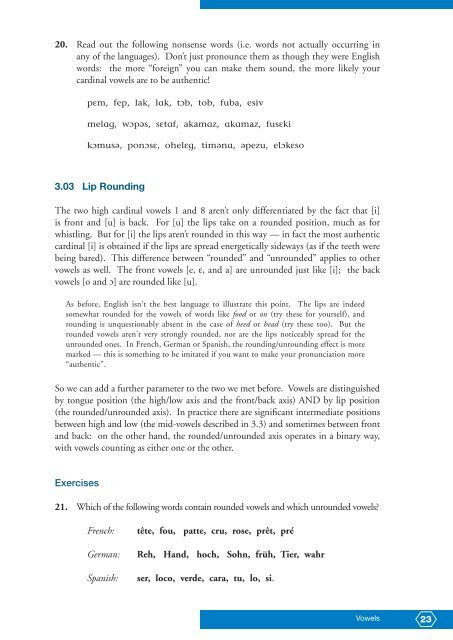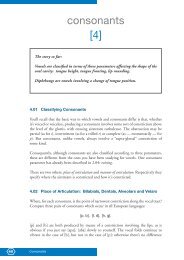PHONETICS MANUAL.indd - HumBox
PHONETICS MANUAL.indd - HumBox
PHONETICS MANUAL.indd - HumBox
You also want an ePaper? Increase the reach of your titles
YUMPU automatically turns print PDFs into web optimized ePapers that Google loves.
20. Read out the following nonsense words (i.e. words not actually occurring in<br />
any of the languages). Don’t just pronounce them as though they were English<br />
words: the more “foreign” you can make them sound, the more likely your<br />
cardinal vowels are to be authentic!<br />
pEm, fep, lak, lAk, tOb, tob, fuba, esiv<br />
melAg, wOp@s, sEtAf, akamAz, AkAmaz, fusEki<br />
kOmus@, ponOsE, ohelEg, tim@nA, @pezu, elOkEso<br />
3.03 Lip Rounding<br />
The two high cardinal vowels 1 and 8 aren’t only differentiated by the fact that [i]<br />
is front and [u] is back. For [u] the lips take on a rounded position, much as for<br />
whistling. But for [i] the lips aren’t rounded in this way — in fact the most authentic<br />
cardinal [i] is obtained if the lips are spread energetically sideways (as if the teeth were<br />
being bared). This difference between “rounded” and “unrounded” applies to other<br />
vowels as well. The front vowels [e, E, and a] are unrounded just like [i]; the back<br />
vowels [o and O] are rounded like [u].<br />
As before, English isn’t the best language to illustrate this point. The lips are indeed<br />
somewhat rounded for the vowels of words like food or on (try these for yourself), and<br />
rounding is unquestionably absent in the case of heed or head (try these too). But the<br />
rounded vowels aren’t very strongly rounded, nor are the lips noticeably spread for the<br />
unrounded ones. In French, German or Spanish, the rounding/unrounding effect is more<br />
marked — this is something to be imitated if you want to make your pronunciation more<br />
“authentic”.<br />
So we can add a further parameter to the two we met before. Vowels are distinguished<br />
by tongue position (the high/low axis and the front/back axis) AND by lip position<br />
(the rounded/unrounded axis). In practice there are significant intermediate positions<br />
between high and low (the mid-vowels described in 3.3) and sometimes between front<br />
and back: on the other hand, the rounded/unrounded axis operates in a binary way,<br />
with vowels counting as either one or the other.<br />
Exercises<br />
21. Which of the following words contain rounded vowels and which unrounded vowels?<br />
French:<br />
German:<br />
Spanish:<br />
tête, fou, patte, cru, rose, prêt, pré<br />
Reh, Hand, hoch, Sohn, früh, Tier, wahr<br />
ser, loco, verde, cara, tu, lo, si.<br />
Vowels<br />
23






